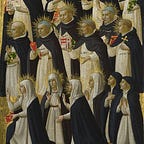St Margaret of Antioch
T/W: violence
It seems fitting to begin this blog with the saint who first captured my imagination and set me on the path to studying holy women in more depth, St Margaret of Antioch. I had never heard of St Margaret until I was flicking through a book on gender and holiness and came across her story. Margaret became a very important saint with a huge cult following in the later Middle Ages; perhaps medieval audiences were as enraptured by her story as I was.
Margaret of Antioch is thought to have lived in the early days of Christianity under the persecutions of the Roman Emperor Diocletian, although there is no historical evidence for her existence as with so many early saints. The story goes that she was the daughter of the patriarch of Antioch, a pagan, but was brought up by a nurse who converted her to Christianity. At the age of fifteen she was spotted by a prefect (an official of the Roman state) named Olybrius. He was so struck by her beauty that he immediately fell in love with her and claiming he would take her either as his wife or concubine. However, Margaret would have none of this, defiantly claiming her Christianity and admonishing Olybrius for not believing in Christ. For this outburst, she was imprisoned.
Pushed to renounce her Christianity, her refusal led to her vicious torture that was so violent even Olybrius, who had instigated it, could not look on. Nevertheless, Margaret remained defiant that these tortures would save her soul. It was after these tortures that the most famous episode in Margaret’s story occurred. She was returned to her cell, and there prayed to be shown visibly her enemy. A huge dragon appeared and filled the cell, opening wide its mouth and swallowing her whole. From inside the stomach of the dragon, Margaret made the sign of the cross and burst out from the dragon, which then disappeared at this sign of faith. But Margaret’s trials were not over; next the Devil appeared in the shape of a man. Margaret was not fazed, grabbed the Devil by the head and threw him to the ground, pinning him there with her foot on his neck. She demanded that he explain exactly why he had come to torment her and why he chose to tempt Christians. The Devil explained that he had wanted to get her to obey the prefect’s orders and renounce her Christianity, and that he tempted Christians because he had been denied happiness, and thus took out his bitterness on the virtuous men and women he tempted. Margaret listened to the Devil only for a short time until her patience was run out and she cried “Be gone, wretch!”. The Devil disappeared.
Having defeated the Devil himself, Margaret no longer feared Olybrius. She was brought before the judge the next day and refused to offer a sacrifice to the pagan gods. She was tortured; stripped and seared with blazing torches, then bound and plunged into a tank of water. At that moment, a huge earthquake split the ground where Margaret was. The crowd looked on in horror, then in amazement, as Margaret emerged unscathed from the rubble. Five thousand pagans in the crowd immediately converted to Christianity when faced with this miracle. Olybrius, fearful of this sudden mass conversion, ordered Margaret to be beheaded. Before her death, Margaret knelt to pray, praying both for herself and her persecutors, and for all women in the peril of childbirth whom she would protect if they invoked her name. She was then beheaded.
The story of St Margaret is certainly an exciting one, and my favourite simply for the reason that she fights a dragon and the devil without so much as breaking a sweat. The cult of St Margaret is thought to have been brought over to Western Europe during the Crusades of the tenth and eleventh centuries as it was only in the later Middle Ages that she grew hugely in popularity, particularly in England. She was especially venerated as a protector of women in childbirth, both because of her promise at death, and also because she herself burst from the stomach of a dragon in a semi-birth-like way. In art of the period she usually appears with the dragon, in much the same way as images of St Michael and St George, skewering it with a lance. As with so many of the early virgin martyr saints, she has since been rejected from the saintly canon by the Roman Catholic church as her story is widely regarded as fictitious. However, this does not detract from the importance she had as a saint in the Middle Ages, nor from her place as my very favourite saint. Who could not be interested by a badass who beat up the Devil?
Further Reading
My summary of the life of St Margaret is based on the Golden Legend by Jacobus de Voragine and the Legends of Holy Women by Osbern Bokenham. In due course I hope to provide more information about these works in a dedicated sources section of the blog for those who are interested.
Gender and Holiness: Men, Women and Saints in Late Medieval Europe, edited by Sam Riches and Sarah Salih. This was the book that initially sparked my interest in St Margaret.
A Maid with a Dragon: The Cult of St Margaret of Antioch in Medieval England by Julia Dresvina
